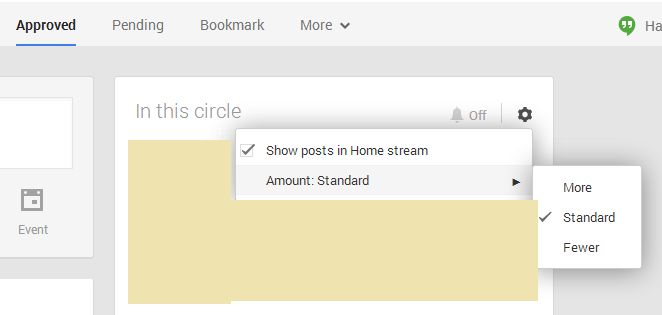Preamble
Google+ is one of the youngest social networks around. Because it is sponsored by Google, this social network is growing faster than any other social network. It's not Number 2 after Facebook - and Facebook has been around for quite a while longer.I enjoy Google+ because I'm interested in photography and evolving my appreciation, my taste and my skill.
I generally like Google+ but some people have mixed experiences. Here are some tips to help you enjoy yourself there.
Incoming Traffic
1. Create three circles. Name them Favourites, Approved, Pending.2. Limit how many Favourites you have. If you have about 20 real true friends in real life, well, that's these.
3. Limit how many Approved you take in. If you feel they will overwhelm, limit these to 2x what you have in Favourites
4. Put the rest into Pending.
5. Set the volume of each circle contributing to the Home Stream.
- Favs should be More.
- Approved should be Fewer
- Pending should not Show in the Home Stream
6. Do not add people just because they add you
7. Set Community posts to zero volume so that they do not invade your Home Stream.
Tweak points 2, 3 and 5 for your Home Stream
8. If the Home Stream continues to be overwhelmed and you are missing really favourite persons, do not visit the Home Stream. Only visit the Favourites, Approved or Pending directly.
Outgoing Traffic
2. At the same time, establish you own identity, not the Community's by posting your own flavour of posts directly from yourself, not into the Community. If you feel that once in a while you want to share into the Community, post directly first, and then reshare into the Community. Donot only post into the Community because Community posts do not automatically appear in the public.
3. Post to Public to encounter new people. Participate in Themes to meet birds of a feather. On the other hand, if you have had too many encounters with strangers you don't like, create an Outgoing Circle to post out to.
Points People Ponder
A. Do not gauge a person's worth by the number of followers. That is not a measure of worth
B. Do not gauge a photo's worth by the number of plusses. That is not a measure of worth.
C. If people like you or people like your photo - it just means someone does. Be happy. Don't compare 10 against 10000 plusses or followers.




